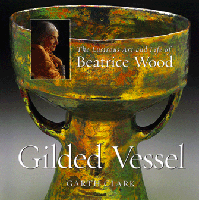Beatrice Wood (March 3, 1893 - March 12, 1998) was an American artist and ceramicist, who late in life was dubbed the "Mama of Dada," and served as a partial inspiration for the character of Rose DeWitt Bukater in James Cameron's 1997 film, Titanic. Beatrice Wood died nine days after her 105th birthday in Ojai, California.
Childhood
During this time period, Wood was introduced to Marcel Duchamp, who in turn introduced her to her first great love interest, Henri-Pierre Roché, a man twice her age. She worked with Duchamp and Roché in the 1910s to create The Blind Man, a magazine that was one of the earliest manifestations of the Dada art movement in New York City.
 Dada and the Avant-garde
Dada and the Avant-gardeThough she was involved with Roché, the two would often spend time with Duchamp, creating a love triangle. Biographies of Wood traditionally link Roché's novel (and the consequent film), Jules et Jim, with the relationship between Duchamp, Wood, and himself [2], [3]. Other sources link their triangle to Roché's unfinished novel, Victor, and Jules et Jim with the triangle between Roché, Franz Hessel and Helen Hessel [4]. Beatrice Wood commented on this topic on p. 136 of her 1985 autobiography, I Shock Myself:
Roché lived in Paris with his wife Denise, and had by now written Jules et Jim...Because the story concerns two young men who are close friends and a woman who loves them both, people have wondered how much was based on Roché, Marcel, and me. I cannot say what memories or episodes inspired Roché, but the characters bear only passing resemblance to those of us in real life!
Roché, Duchamp, and Jules et Jim
Wood was next introduced to the art patrons, Walter and Louise Arensberg (who would become her lifelong friends). They held regular gatherings in which artists, writers, and poets were invited for intellectual discussion. Besides herself, Duchamp, and Roché, the group included Man Ray and Francis Picabia. Beatrice Wood's relationship with them and others associated with the avant-garde movement of the early 20th century, earned her the designation "Mama of Dada." Beatrice did not stay at the academy because it was too academic for her
The Arensbergs and their circle
In her early forties, after a succession of failed artistic careers (most notably as an actress) and an annulled marriage, Beatrice moved back to Los Angeles, California.
It was at this time that she bought a pair of baroque plates with a luster glaze. She wanted to find a matching teapot to go along with it, but was unsuccessful. Deciding to make the teapot herself, she enrolled in a ceramic class at Hollywood High School. This hobby turned into a passion that would last over the next sixty years, as she developed a unique form of luster-glaze technique that proved successful.
In 1947, Beatrice felt that her career was established enough for her to build a home. She settled in Ojai, California in 1948 to be near the Indian philosopher Jiddu Krishnamurti and became a life long member of the Theosophical Society - Adyar, events which would greatly influence her artistic philosophies. She also taught and lived at the Happy Valley School.
Ever the comedienne, when asked the secret to her incredible longevity, she would respond, "I owe it all to chocolate and young men."
In 1994, the Smithsonian Institution named Wood an "Esteemed American Artist."
Ojai, California
Books:
Clark, Garth, "Gilded Vessel: The Lustrous Life and Art of Beatrice Wood". Guild Publishing, 2001.
Wallace, Marlene, "Playing Chess With the Heart: Beatrice Wood at 100". San Francisco: Chronicle Books, 1994.
Wood, Beatrice, "I Shock Myself: The Autobiography of Beatrice Wood". 1985. San Francisco: Chronicle Books, 2006.

No comments:
Post a Comment